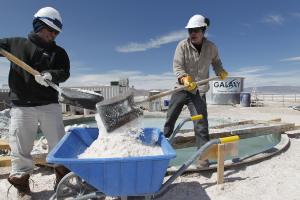Question of the week
Will fusion run out of fuel?
9 Jul 2018
-
R.A.
One of the paradoxes of fusion, the virtually inexhaustible energy of the future, is that it relies on an element that does not exist—or just barely. Tritium, one of the two hydrogen isotopes implemented in ITER and in future fusion reactors, is only present in nature in trace amounts.
Chile, Bolivia and Argentina are presently the main producers of lithium. Here, in northern Argentina, workers extract lithium carbonate from salt flats at an altitude of 4,000 metres. Photo Reuters
The only source of readily available tritium comes from heavy-water fission reactors such as the CANDU type (developed by Canada in the 1950-60s, and adopted since in Romania, South Korea, and India). However, the tritium generated by these reactors is just a by-product and quantities remain relatively small.
Tritium production from CANDU reactors worldwide is on the order of 20 kilos per year—not much, but enough to fuel ITER for the planned fifteen years of its deuterium-tritium operation phase.
Operating an industrial electricity-producing fusion plant, by contrast, will require an average of 70 kilos of tritium per gigawatt of thermal power (per year at full power). And if all goes well, there could be hundreds, if not thousands, of fusion plants operating in the early decades of the 22nd century.
Hence the question: where will all this tritium comes from?
Nature, as if anticipating the challenge, offers a solution that combines elegance and efficiency—the fusion reaction itself will produce the tritium that, in turn, will continue to fuel the reaction. What's more, the process will take place within the vacuum vessel in a safe, continuous, closed cycle.
The key to this process is isotope 6 of lithium (Li-6) which, when impacted by neutrons, generates tritium. ITER will test different concepts of "tritium breeding modules," each one unique in its architecture and cooling system, as well as in its structural materials, the form of lithium-compound involved, and the manner in which it will be extracted.
Whether liquid or solid, compounds will consist of enriched lithium with a proportion of Li-6 in the 50 percent range.
Hence a second question: will there be enough lithium to sustain tritium production and make true on the promise of providing virtual unlimited energy for the centuries to come?
Jaap van der Laan, a nuclear engineer in ITER's Tritium Breeding Blanket Systems Section, has a simple and quick answer. "Lithium availability will not be an issue for let's say the next thousand years ..."
His confidence is rooted in a few basic figures and extrapolations. "There are approximately 50 million tonnes of proven lithium reserves in the world¹, which means about 3 million tonnes of Li-6."
Like most minerals, lithium is also present in seawater. At a concentration of 0.1 part per million, the mass of lithium contained in the oceans of the planet is estimated at 250 billion tonnes. Innovative, low-energy extraction processes are being developed, particularly at Japan's Rokkasho Fusion Energy Centre.
Fusion will not be the only avid consumer of lithium. The ever-growing lithium-ion battery market for laptops, mobile phones, cordless power tools (and of course electrical vehicles) will claim its share. This market already gobbles 40 percent of the world's lithium production² and its appetite will keep growing as electric cars gain in popularity.
"But I don't see this market as competitive in terms of physical resources any time soon," says Jaap.
Now let's imagine a future where 10,000 industrial fusion plants are operating worldwide—a far-fetched projection, perhaps, but one Jaap likes to use for his demonstration.
It takes 140 kilos of Li-6 to obtain the 70 kilos of tritium necessary to producing one gigawatt of thermal power for one year.
Assuming an availability of 80 percent and a conversion efficiency from thermal to electrical power of 30 percent, the production of one gigawatt of electrical power (the estimated size of an average fusion reactor) will require approximately 500 kilos of Li-6 per year, which would bring the total requirement for 10,000 reactors to 5,000 tonnes annually.
Obtaining 5,000 tonnes of the precious isotope will require processing (by way of well-established isotope separation techniques) approximately 70,000 tonnes of "regular" lithium ... still a very small fraction of available resources.
Fusion specialists generally consider that, in a world where all energy would be produced by fusion, the quantity of lithium ore present in landmass would be sufficient to provide the required tritium for several thousand years. As for lithium present in oceans, it could last us millions of years.
By that time, however, mankind will probably look at deuterium-tritium fusion the way we look at peat fires today—a most primitive technique based on a particularly low-yield fuel ...
¹ It is generally considered that half of the world's reserve lays in brine deposits, the other half in rocks.
² Lithium is used for batteries (40 percent of the total production), glass manufacturing (24 percent), lubricants (12 percent), refrigeration (4 percent) metallurgy, (3 percent), etc.


